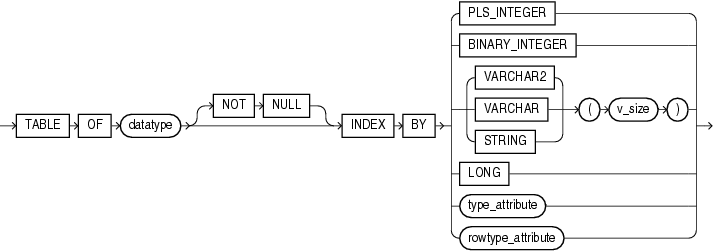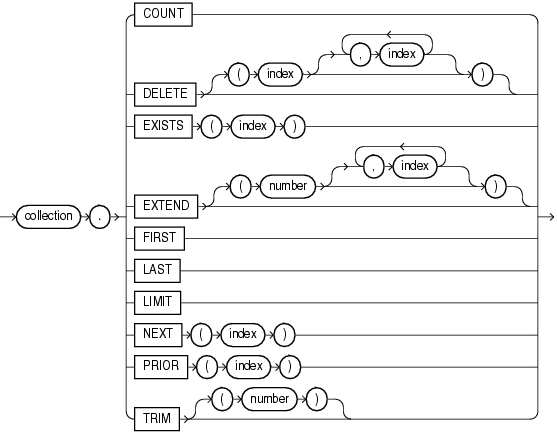collection有三个

CREATE OR REPLACE PACKAGE My_Types AUTHID CURRENT_USER IS TYPE My_AA IS TABLE OF VARCHAR2(20) INDEX BY PLS_INTEGER; FUNCTION Init_My_AA RETURN My_AA; END My_Types; / CREATE OR REPLACE PACKAGE BODY My_Types IS FUNCTION Init_My_AA RETURN My_AA IS Ret My_AA; BEGIN Ret(-10) := ‘-ten‘; Ret(0) := ‘zero‘; Ret(1) := ‘one‘; Ret(2) := ‘two‘; Ret(3) := ‘three‘; Ret(4) := ‘four‘; Ret(9) := ‘nine‘; RETURN Ret; END Init_My_AA; END My_Types; / DECLARE v CONSTANT My_Types.My_AA := My_Types.Init_My_AA(); BEGIN DECLARE Idx PLS_INTEGER := v.FIRST(); BEGIN WHILE Idx IS NOT NULL LOOP DBMS_OUTPUT.PUT_LINE(TO_CHAR(Idx, ‘999‘)||LPAD(v(Idx), 7)); Idx := v.NEXT(Idx); END LOOP; END; END; /
没有null,自动变成empty
需要自己写初始化函数
index by得变量类型有限制,不是随意得

DECLARE TYPE Foursome IS VARRAY(4) OF VARCHAR2(15); -- VARRAY type -- varray variable initialized with constructor: team Foursome := Foursome(‘John‘, ‘Mary‘, ‘Alberto‘, ‘Juanita‘); PROCEDURE print_team (heading VARCHAR2) IS BEGIN DBMS_OUTPUT.PUT_LINE(heading); FOR i IN 1..4 LOOP DBMS_OUTPUT.PUT_LINE(i || ‘.‘ || team(i)); END LOOP; DBMS_OUTPUT.PUT_LINE(‘---‘); END; BEGIN print_team(‘2001 Team:‘); team(3) := ‘Pierre‘; -- Change values of two elements team(4) := ‘Yvonne‘; print_team(‘2005 Team:‘); -- Invoke constructor to assign new values to varray variable: team := Foursome(‘Arun‘, ‘Amitha‘, ‘Allan‘, ‘Mae‘); print_team(‘2009 Team:‘); END; /

CREATE OR REPLACE TYPE nt_type IS TABLE OF NUMBER; / CREATE OR REPLACE PROCEDURE print_nt (nt nt_type) AUTHID DEFINER IS i NUMBER; BEGIN i := nt.FIRST; IF i IS NULL THEN DBMS_OUTPUT.PUT_LINE(‘nt is empty‘); ELSE WHILE i IS NOT NULL LOOP DBMS_OUTPUT.PUT(‘nt.(‘ || i || ‘) = ‘); DBMS_OUTPUT.PUT_LINE(NVL(TO_CHAR(nt(i)), ‘NULL‘)); i := nt.NEXT(i); END LOOP; END IF; DBMS_OUTPUT.PUT_LINE(‘---‘); END print_nt; / DECLARE nt nt_type := nt_type(); -- nested table variable initialized to empty BEGIN print_nt(nt); nt := nt_type(90, 9, 29, 58); print_nt(nt); END; /
collection_type ( [ value [, value ]... ] ) DECLARE TYPE Foursome IS VARRAY(4) OF VARCHAR2(15); team Foursome := Foursome(); -- initialize to empty PROCEDURE print_team (heading VARCHAR2) IS BEGIN DBMS_OUTPUT.PUT_LINE(heading); IF team.COUNT = 0 THEN DBMS_OUTPUT.PUT_LINE(‘Empty‘); ELSE FOR i IN 1..4 LOOP DBMS_OUTPUT.PUT_LINE(i || ‘.‘ || team(i)); END LOOP; END IF; DBMS_OUTPUT.PUT_LINE(‘---‘); END; BEGIN print_team(‘Team:‘); team := Foursome(‘John‘, ‘Mary‘, ‘Alberto‘, ‘Juanita‘); print_team(‘Team:‘); END; /
DECLARE TYPE nested_typ IS TABLE OF NUMBER; nt1 nested_typ := nested_typ(1,2,3); nt2 nested_typ := nested_typ(3,2,1); nt3 nested_typ := nested_typ(2,3,1,3); nt4 nested_typ := nested_typ(1,2,4); PROCEDURE testify ( truth BOOLEAN := NULL, quantity NUMBER := NULL ) IS BEGIN IF truth IS NOT NULL THEN DBMS_OUTPUT.PUT_LINE ( CASE truth WHEN TRUE THEN ‘True‘ WHEN FALSE THEN ‘False‘ END ); END IF; IF quantity IS NOT NULL THEN DBMS_OUTPUT.PUT_LINE(quantity); END IF; END; BEGIN testify(truth => (nt1 IN (nt2,nt3,nt4))); -- condition testify(truth => (nt1 SUBMULTISET OF nt3)); -- condition testify(truth => (nt1 NOT SUBMULTISET OF nt4)); -- condition testify(truth => (4 MEMBER OF nt1)); -- condition testify(truth => (nt3 IS A SET)); -- condition testify(truth => (nt3 IS NOT A SET)); -- condition testify(truth => (nt1 IS EMPTY)); -- condition testify(quantity => (CARDINALITY(nt3))); -- function testify(quantity => (CARDINALITY(SET(nt3)))); -- 2 functions END; /
| Method | Type | Description |
|
|
Procedure |
Deletes elements from collection. |
|
|
Procedure |
Deletes elements from end of varray or nested table. |
|
|
Procedure |
Adds elements to end of varray or nested table. |
|
|
Function |
Returns |
|
|
Function |
Returns first index in collection. |
|
|
Function |
Returns last index in collection. |
|
|
Function |
Returns number of elements in collection. |
|
|
Function |
Returns maximum number of elements that collection can have. |
|
|
Function |
Returns index that precedes specified index. |
|
|
Function |
Returns index that succeeds specified index. |

原文:https://www.cnblogs.com/fqguo24/p/12896614.html